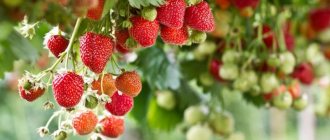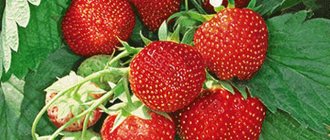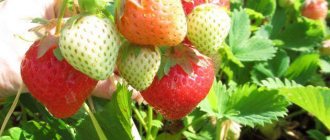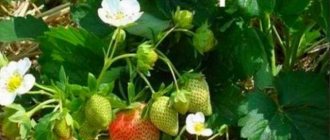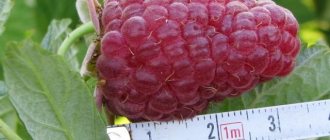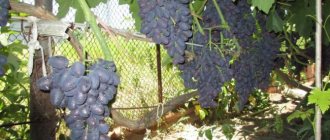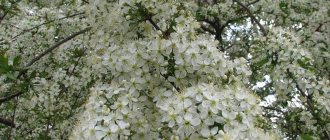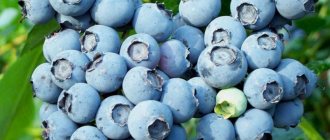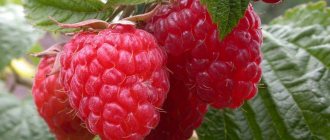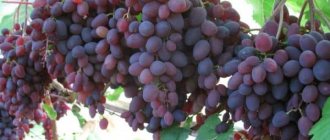Description of the variety
The name translates as “Eve’s delight.” The berry was bred in 2004 in the UK. According to experts, Evis Delight is superior to other varieties in terms of the amount of sugar. It is very tasty and aromatic, and can produce several harvests in one season.
A special feature is the fact that the peduncles are quite strong and erect. They are able to hold large, heavy berries. The bush reaches a height of 30-35 cm. There are many flowers, they are large and have 5-6 petals. This variety is able to withstand winter and is resistant to low temperatures. It can be grown in open space or in a greenhouse.
Leaves:
- large;
- dark green;
- medium wrinkled.
Peculiarity! The formation of whiskers is average, it cannot be called meager, but they are not enough for mass reproduction. From one bush you can get 3-4 rosettes.
Pros and cons of the Avis Delight strawberry variety
In describing the main advantages of the Evis Delight strawberry variety, the following are highlighted:
- high yield rates (up to 1.5 kg of berries are harvested from 1 bush);
- belonging to the remontant type (the ability to harvest in stages throughout the season under neutral daylight conditions);
- suitable for cultivation in greenhouses, in open areas, under film cover;
- adaptability to growing in difficult climatic conditions;
- high frost resistance;
- belongs to the large-fruited type.
The disadvantages of the hybrid, according to the observations of gardeners, are:
- susceptibility to anthracosis;
- low ability to reproduce.
Characteristics of the berry
The berries have the following characteristics:
- they are large and have a conical shape;
- bright red in color;
- the surface is smooth and shiny.
The pulp is dense, not too soft. It is bright red in color and tastes sweet. It has a pleasant aroma that is much stronger than other strawberry varieties.
From one bush you can collect 1.5-2 kg of fruit. On average, the fruits weigh 25-30 g, but with proper care the plant can produce larger berries. There are cases when the weight reached 45-50 g.
Important! Gardeners note that this berry is resistant to frost, heat and many diseases. It is considered hardy, but requires regular watering. If you take care of the plant, the fruits will have a beautiful appearance and are easy to transport. The berries retain their shape and do not lose their presentation.
Varietal characteristics of strawberries
This variety of strawberry has a number of characteristic features that distinguish it from other varieties.
Bush size and leaf blade appearance
The bushes are large, reaching a height of 35-40 cm, but they look compact and take up little space due to weak root formation. The leaves are large, medium wrinkled, dark green in color.
Flowering and pollination
Strawberry flowering time is mid to late. The flowers are numerous and large. The peduncles are long, erect, directed upward and located above the level of the leaf blades. This makes harvesting easier and protects the fruit from dirt, diseases and pests.
When growing plants in open ground, flowers are pollinated naturally. When cultivated at home, they need to be pollinated manually, using a brush.
Ripening time and yield
The variety is remontant and produces a high yield within 2 years from the moment of planting. Fruiting continues from July to October. The weight of 1 berry is 20-40 g. From 1 bush you can collect up to 1.5 kg of fruit per season.
Description of Kent variety strawberries, planting and care rules
Read
Taste qualities of the fruit and its further sale
The berries have a very sweet taste and a strong strawberry aroma. The fruit pulp is quite dense, thanks to which they are stored for a long time and can withstand transportation without losing their presentation. The purpose of the fruits is universal: they can be eaten fresh and used for preparing various desserts, drinks and winter preparations.
Resistance to adverse conditions
The plant adapts well to different climatic conditions - it tolerates bad weather without problems, while maintaining high yield and quality of fruits.
Susceptibility to diseases and insects
The culture is resistant to most diseases, but is susceptible to anthracosis. The variety is not resistant to damage by insect pests.
Reproduction
Reproduction occurs with the help of whiskers. One bush produces 3-4 rosettes. The plant is not propagated using seeds: this method requires more effort and time.
Whiskers are formed in small numbers, but usually they are enough for reproduction. They are medium in size and light green in color. With proper care, rosettes take root perfectly and form a strong root system. You cannot bury rosettes deeply; they are left on the surface and watered regularly.
Dividing the bush is also popular for its simplicity and ease.
Landing
Before planting, it is necessary to select a suitable site. It should be sunny, not in the shade. The place should not be too windy.
When landing you need to remember:
- loosen the soil a little, remove weeds;
- there should be 20-24 cm between seedlings;
- There should be a distance of 35-40 cm between rows of plants.
Sockets should not be buried to great depths; they are lightly covered with earth. You need to be especially careful with seedlings: careless movements can injure them, which will negatively affect their health in the future.
Attention! Immediately after planting, the seedlings are fed and watered. Potassium-phosphorus fertilizers are ideal for this variety: with their help, growth will occur quickly, and its health will prevent the occurrence of diseases.
The nuances of growing a plant
The key to obtaining a large harvest depends on many factors. It all starts with choosing the right location. Agricultural technology plays a big role. Failure to follow the rules will not give the desired result. It is this stage that leads to receiving negative reviews.
Selection and preparation of a landing site
Strawberry bushes are located on the southwest side. The site should be level with slight upward development. Avis Delight is not grown in the northeast and lowlands. Groundwater on the site must flow at a depth of at least 0.6 m.
The hybrid needs stable daylight, so planting in dark places is not recommended. Bad areas for strawberries are the shade of spreading fruit and berry trees. The root system of trees prevents the development of strawberries.
Preparation of planting material
Strawberry rosettes, ready to be planted in a new place, are not watered for 3-5 days. Only before the procedure itself is abundant watering carried out. Saturation with moisture helps to free the socket from the container. The peat cup is planted directly in a new place without affecting the root system.
Landing rules
For 1 sq. m of land, no more than 4 bushes are planted. 0.3 m of free space is maintained between the bushes. Between rows - 0.5 m.
Rosettes ready for planting are placed in pre-dug holes and then sprinkled with soil. The final stage is to water the plant abundantly. During planting, care should be taken to ensure that the root system is not damaged. The ability to take root in a new place and the speed of growth and development depend on this part of the plant.
Watering
This variety loves water very much, so it needs to be watered regularly. Water in moderation so that the soil does not become too wet and water does not accumulate, otherwise the plant will die. Drip irrigation is ideal: it allows you to fill both the bushes and the soil with moisture in the right amount.
There are some things to keep in mind:
- after planting, water every day, the same applies to the summer period;
- two months after planting, strawberries are watered once every 3-4 days;
- If it’s the rainy season, you can refuse watering: the soil will be moistened naturally.
Interesting! The gardener must focus on the condition of the soil. If it is moist, you will have to refuse watering, and vice versa, if the soil looks dry on a hot day, it can be watered several times a day.
Care and feeding
Caring for this plant includes the following:
- regular watering;
- weed removal;
- feeding;
- mulching;
- inspection of the plant to assess its health; if symptoms of disease are found, treatment must be taken.
Weeds must be removed regularly, otherwise the growth and ripening of the crop will be complicated. Feed once every 10-14 days. Mullein and chicken droppings are suitable for this. Mulching is carried out once every 8-10 days.
Important! It is necessary to regularly inspect the plant and the soil around it to understand whether there is any disease or not. At the first signs of illness, appropriate measures must be taken for treatment.
Recommendations for caring for the variety
It has individual nuances that must be taken into account if a person wants to get a good and stable harvest.
Watering rules
The berry variety needs regular and abundant watering. In this case, there should be no waterlogging of the soil. Irrigation rules are as follows:
- watering alternates with drip and root;
- settled water is used;
- it shouldn't be cold.
Watering increases during fruit formation. The soil is saturated with moisture daily. At the same time, make sure that there is no stagnation of water.
Fertilizers and fertilizers
In spring, the crop is fertilized with complexes containing nitrogen. In summer, the emphasis is on potassium and phosphorus. In the latter case, the substances give the plant strength to bear fruit again.
Mulching and loosening
Covering the soil with mulch reduces the frequency of watering, as well as the growth of weeds. The procedure has another important advantage - it improves the soil structure for growing strawberries. Mulch can be inorganic and organic:
- straw;
- coke shavings;
- agrofibre;
- humus;
- hay;
- needles.
When caring for strawberry beds, do not forget about loosening. The procedure is carried out not only after watering, but also after precipitation. Loosening is done between the bushes, trying to create neat grooves.
Preparing for winter
It usually begins after harvest. Weeds are removed from the garden beds, bushes are treated with herbicides and pruned. Strawberries should not have many leaves, as this risks freezing. Branches with signs of disease, dry and damaged must be removed.
Then they move to the shelter. The needles are used for regions with extreme low temperatures. The fallen snow also serves as cover for the strawberries.
Diseases and pests
This variety usually does not get sick and is highly resistant to any diseases. However, sometimes diseases still arise.
Typically this is:
- gray rot;
- white rot;
- powdery mildew.
Slugs, weevils, strawberry leaf beetles, aphids, mole crickets, and strawberry mites can harm strawberries. To repel pests and prevent the development of diseases, it is necessary to regularly spray the plant with special solutions. These can be ready-made solutions, purchased in a store, or prepared independently.
You can prepare infusions of calendula and cucumber herb. In addition, onions or garlic are planted in the garden every 30 cm. They repel pests. A solution of wood ash is also suitable for treating plants. Mix 2 kg of ash and a bucket of water. The resulting liquid is used to treat the soil and bushes.
Attention! To maintain the health of the plant and prevent the development of diseases, mustard powder is used. You need to mix 10 g of mustard powder and a bucket of water. This solution will only bring benefits. It has shown high efficiency in practice. They spray both bushes and soil.
Advantages and disadvantages of the variety in comparison with others
The advantages of this type include:
- repairability;
- high productivity;
- good taste and marketability of fruits;
- resistance to extreme weather conditions;
- disease resistance;
- the possibility of growing in open ground, in greenhouses, tunnels and at home;
- possibility of commercial use;
- the presence of upward-pointing peduncles, simplifying harvesting;
- the possibility of growing seedlings from independently collected seeds.
The disadvantages include:
- the need to renew plantings every 2 years to maintain high yields;
- susceptibility to anthracosis;
- susceptibility to insect pests;
- weak ability to adapt.
Reviews from gardeners
Tatyana, 36 years old: “I chose this variety five years ago. Then I didn’t know how to care for him, a friend helped. I was afraid that I would be unhealthy due to my inexperience, or that I would get sick. However, these were just fears. The variety turned out to be unpretentious. Taking care of him is a pleasure. Nothing complicated! The bush grew large and large, and the berries pleasantly surprised me with their large size and bright red hue. I am very glad that I once chose it. I really like the taste of the berries, and their aroma is incredible! You can make desserts and jam; they are healthy to eat fresh. Both adults and children will love this delicacy. Happy with my choice.”
Ekaterina, 45 years old: “Recommended by my aunt. She has been gardening for a long time and loves it very much. One day I made up my mind, I was nervous. My aunt reassured me and said that the plant does not require too much care and anyone can cope with this task. Indeed, she turned out to be right: the plant grew big and strong, the red berries with a pleasant aroma immediately attracted me. I made a lot of jam and sweet desserts. Be sure to try Avis Delight, you will definitely like it!”
Alexander, 42 years old: “I always had a lot of berries in the garden. I love experimenting, trying new varieties. Once I found out about Evis on the Internet. I immediately wanted to grow it. I read the rules of care and did not delay it. Planting turned out to be simple, the seedlings withstood changes in air temperature and turned out to be very strong. I was pleased with the rich harvest. I recommend to everyone!"
Strawberry Evis Delight is a relatively new variety that many experienced gardeners have not yet had time to become familiar with. The berries are very sweet and have an attractive appearance. Once you try this variety, the gardener will no longer be able to refuse it. A rich harvest will be a reward for careful care.
